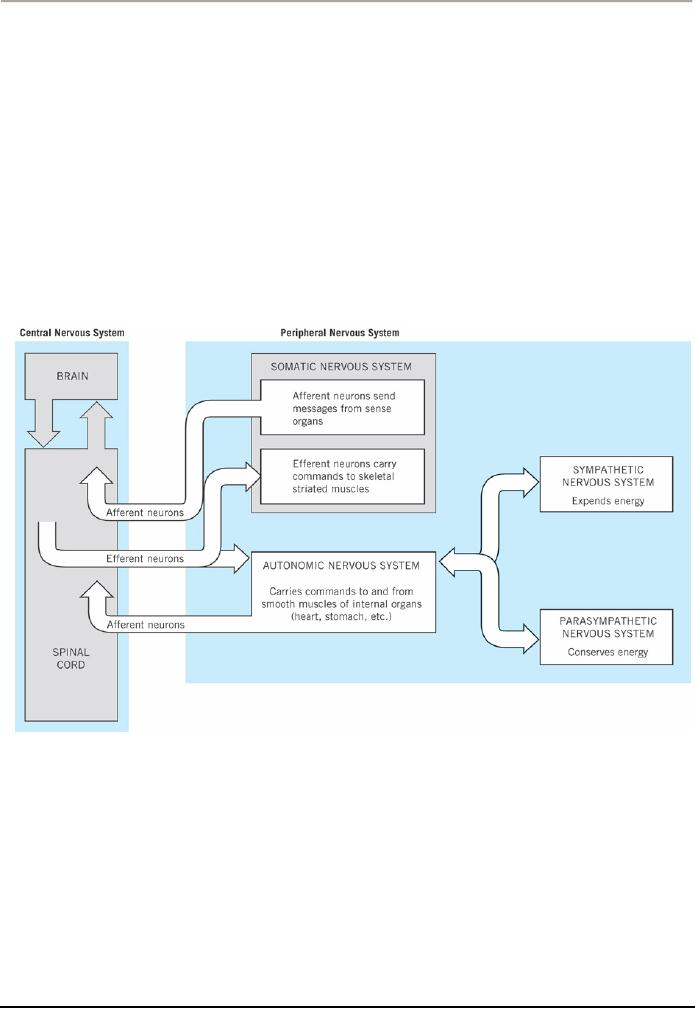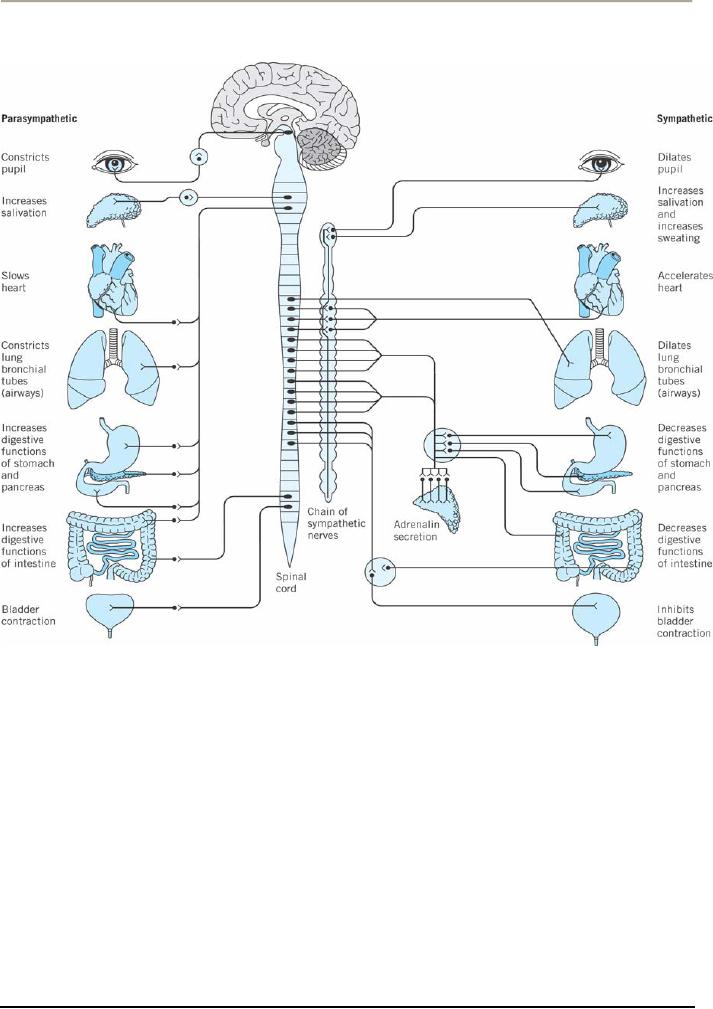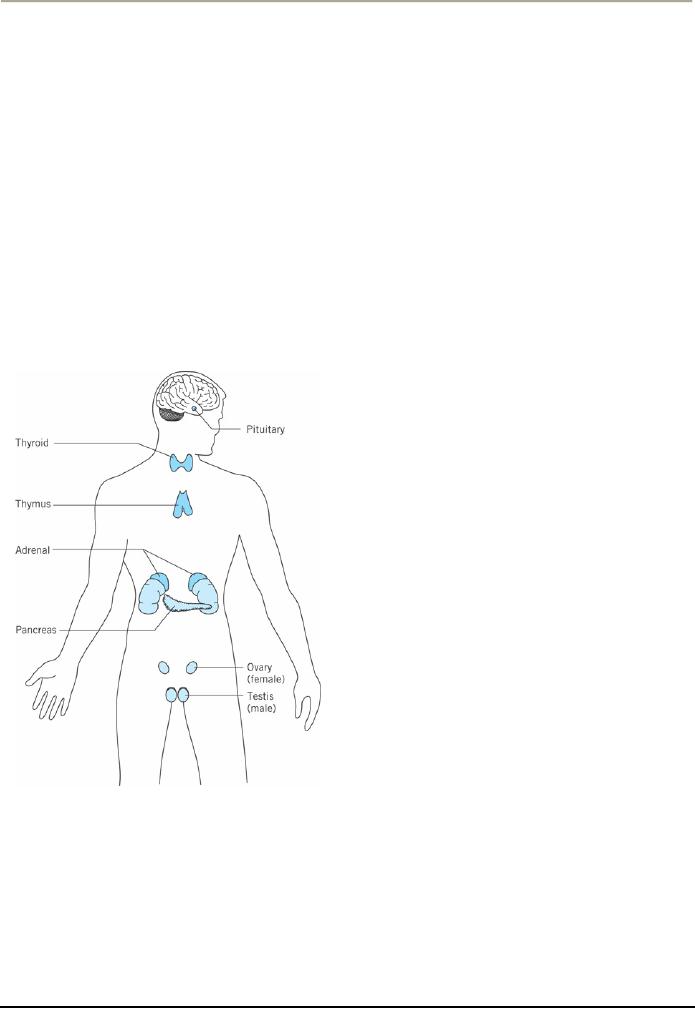 |

Health
Psychology PSY408
VU
LESSON
08
THE
FUNCTION OF NERVOUS SYSTEM AND
ENDOCRINE GLANDS
The
Peripheral Nervous
System
As
you can see in the diagram,
the peripheral
nervous system has
two parts:
a-
Somatic Nervous System
b-
Autonomic Nervous System.
The
somatic nervous system is
involved in both sensory and
motor functions, serving mainly the
skin
and
skeletal muscles. The
autonomic nervous system activates
internal organs, such as the
lungs and
intestines,
and reports to the brain the current
state of activity of these
organs.
In
the somatic
nervous system,
afferent neurons carry
messages from sense organs
to the spinal cord, as
you
can see the diagram.
Efferent neurons carry
messages to, and activate,
striated
(grooved)
skeletal
muscles,
such as those in the face,
arms, and legs, that we
can move voluntarily. A disorder called
myasthenia
gravis
can
develop at the junction of these muscles
and neurons, weakening
muscle function of the head
and
neck.
This produces characteristic
symptoms-- such as drooping
eyelids, blurred vision, and
difficulty
swallowing
and breathing--and can lead
to paralysis and death.
Although medical treatment is effective
in
restoring
muscle function, some
symptoms may recur when the
person is under stress (AMA,
1989).
The
diagram also shows that in
the autonomic nervous system, neurons
carry messages between the
spinal
cord
and the smooth
muscles
of the internal organs, such as the
heart, stomach, lungs, blood
vessels, and
glands.
This system itself has
two divisions, the sympathetic
and
parasympathetic,
which often act in
opposite
ways, as you will see in this
next diagram.
35

Health
Psychology PSY408
VU
The
sympathetic nervous system
helps us mobilize and expend
energy in responding to
emergencies,
expressing
strong emotions, and performing strenuous
activity. For instance,
suppose you are crossing
a
street,
notice a speeding car barreling toward
you, and hear its brakes
start to squeal. The
sympathetic
nervous
system instantly moves into action,
producing several simultaneous
changes--for example, it
speeds
up the heart, dilates certain
arteries to increase blood
flow to the heart and
skeletal muscles,
constricts
other arteries to decrease
blood flow to the skin and
digestive organs, decreases salivation,
and
increases
perspiration. These changes, in general,
enable you to mobilize
energy, and you leap to
safety out
of
the cars path. This system is called
"sympathetic" because it acts in
agreement with your
current
emotional
state.
What
does the parasympathetic division
do? The prefix "Para"
means
"alongside of"--this division
acts
alongside
of, and often in opposition
to the sympathetic division. The
parasympathetic nervous
system
regulates
"quiet" or calming processes,
helping our individual organ
systems conserve and store
energy. One
example
of parasympathetic activity can be
seen in the digestion of food. When
you eat a meal, the
parasympathetic
nervous system carries
messages to regulate each
step in the digestive process,
such as by
increasing
salivation and stomach contractions.
Another example can be seen
in the course of emotional or
36

Health
Psychology PSY408
VU
emergency
reactions--when an emergency has
passed, the parasympathetic division
helps restore your
normal
body state.
Communication
within the peripheral nervous system is
handled by 12 sets of cranial
nerves, most
of which
originate
in the brainstem. The Vagus
nerve extends
from there to muscles of
most major body organs,
such
as
the airways, lungs, heart,
and intestines, and is
directly involved in the regulation of
sympathetic and
parasympathetic
activity. Efferent messages
from the brain can target
specific organs to increase or
decrease
their
function. As you now
realize, the nervous system is
connected to and regulates
all of our other
body
systems;
and the brain is the control
center.
THE
ENDOCRINE SYSTEM
The
endocrine system consists of a set of
glands that often work in
close association with the
autonomic
nervous
system. These systems share
an important function: they communicate
with various parts of
the
body.
But they do this in somewhat different
ways. Whereas the nervous
system uses both electrical
and
chemical
messages, the endocrine system
communicates only with
chemical substances, which
are called
hormones.
Each endocrine gland secretes
specific hormones directly
into the bloodstream, which
carries
these
chemicals to various parts of the
body.
The
diagram shows where several
important endocrine glands are
located. Certain chemicals are
produced
by
both the endocrine and nervous
systems and function as both
hormones and
neurotransmitters.
THE
ENDOCRINE AND NERVOUS SYSTEMS
WORKING TOGETHER
How
are the endocrine and nervous
systems associated? The
nervous system is linked to the
endocrine
system
by connections between the hypothalamus
(in the forebrain) and a
gland that lies just
below it-- the
pituitary
gland. The hypothalamus
sends chemical messages directly to the
pituitary gland, causing it
to
37

Health
Psychology PSY408
VU
release
pituitary hormones into the
blood. In turn, most of
these hormones selectively
stimulate the other
endocrine
glands to secrete chemicals.
Because the pituitary gland controls the
secretion of other endocrine
glands,
it is called the "master
gland".
Researchers
have identified dozens of
different hormones that
course through our veins
and arteries. Each
hormone
has its own specific
effects on cells and organs
of the body, thereby directly or indirectly
affecting
psychological
and physical functions.
Some
hormones, such as estrogens
and testosterone, are produced mainly in
females' ovaries (where
egg
cells
develop) and males' testes
(where sperm develop). These
hormones are especially
important in the
development
and functioning of female
and male reproductive systems.
Other hormones affect
blood
pressure,
general body growth, and the
balance of various chemicals,
such as calcium, in the body.
Still other
hormones
help us react to specific
situations we encounter in our
lives.
We
saw earlier that the autonomic
nervous system plays an
important role in our reaction to an
emergency.
So
does the endocrine system through a
process called the
hypothalamus--pituitary--adrenal
axis
(Sternberg
& Gold. 1997).
Let's
see how by returning to the incident in
which you leaped out of the
path of a speeding car. When
the
sympathetic
nervous system reacts to
your emergency, the hypothalamus
immediately sends a hormone
called
Cortico-tropin-releasing
factor to the
pituitary gland. This causes the
pituitary to release ACTH
(adreno-cortico-tropic
hormone) into the blood. The
ACTH then travels throughout
the body and
stimulates
the release of a variety of hormones--
especially those of the adrenal
glands--that affect your
reaction
to the emergency.
Adrenal
Glands
The
adrenal glands are located
on top of the kidneys (see the
diagram). These glands
release several
important
hormones in response to emergencies
and stress. One of these
hormones, Cortisol,
helps control
swelling
when we are injured. If when
you leaped to avoid being
hit by the car you sprained
your ankle, this
hormone
would help reduce swelling.
But continued high levels of
cortisol and similar hormones
over a
long
time can be harmful to the body.
They can lead to high
blood pressure and the
formation of ulcers,
for
example.
Two
other important adrenal
hormones are epinephrine
and
nor-epinephrine
(also
called adrenalin and
noradrenalin).
These hormones work in
conjunction with the sympathetic
nervous system to produce
such
bodily
reactions as speeding up heart
and respiration rates and
increasing the livers sugar output
for quick
energy.
After the emergency has
passed and sympathetic
activity has subsided, some
impact of the
hormones
may continue for a while
because they are still in the
bloodstream.
The
impact of the nervous and endocrine
systems' activities in emergency
situations differs in the speed
and
persistence
of their effect. The nervous
system responds by sending
messages that move instantly to
specific
locations:
once they reach their destination, they
become deactivated or dissipated.
For example, the
nervous
system also produces and
uses epinephrine and nor-epinephrine,
but these chemicals function
as
neurotransmitters,
relaying their commands from
neuron to neuron and having
a localized effect. The
impact
of the message stops quickly,
and persists only if
additional messages are
sent. Hormones from
the
endocrine
system move more slowly and
broadly through the bloodstream,
and their effects can be
delayed
and
long-lasting.
Other
Glands
Several
other endocrine glands are
also important. The
thyroid
gland,
located in the neck,
produces
hormones,
such as thyroxine, that
regulate the body's general activity
level and growth. Disorders
in
thyroid
production are of two types:
hypothyroidism, or
insufficient secretion of thyroid
hormones, and
hyperthyroidism, or
excessive thyroid secretion
(AMA. 1989).
38

Health
Psychology PSY408
VU
Hypothyroidism
leads to low activity levels
and to weight gain. If the condition is
congenital and untreated,
dwarfism
and mental retardation often
result. The condition can be
treated medically by having the
person
take
hormone supplements orally.
Hyperthyroidism leads to high
activity levels, short attention
spans,
tremors,
insomnia, and weight loss.
Untreated people with a common form of
this condition, called
Graves'
disease,
act in a highly restless,
irritable, and confused
manner.
The
thymus
gland,
which is located in the chest, is
quite large in infancy and
childhood but diminishes
in
size
and efficiency after puberty. The
thymus plays an important
role early in life in the development
of
antibodies
and immunities against diseases. We
will discuss the immune system in
one of our later
lectures.
Another
endocrine gland is the pancreas,
which is located below the
stomach. Its main function
is to
regulate
the level of blood sugar, or glucose.
The pancreas does this by
producing two hormones,
glucagon
and
insulin, that
act in opposition. Glucagon raises the
concentration of glucose in the blood,
and insulin
lowers
it. The disorder called
diabetes
mellitus results
when the pancreas does not
produce sufficient
insulin
to balance the action of glucagon. This
imbalance produces excess
blood sugar levels--a
condition
called
hyperglycemia. If this
condition persists and is
untreated, it may cause coma
and death. Diabetes
can
be medically controlled, generally
through diet and either medication or
daily insulin inspections.
39
Table of Contents:
- INTRODUCTION TO HEALTH PSYCHOLOGY:Health and Wellness Defined
- INTRODUCTION TO HEALTH PSYCHOLOGY:Early Cultures, The Middle Ages
- INTRODUCTION TO HEALTH PSYCHOLOGY:Psychosomatic Medicine
- INTRODUCTION TO HEALTH PSYCHOLOGY:The Background to Biomedical Model
- INTRODUCTION TO HEALTH PSYCHOLOGY:THE LIFE-SPAN PERSPECTIVE
- HEALTH RELATED CAREERS:Nurses and Physician Assistants, Physical Therapists
- THE FUNCTION OF NERVOUS SYSTEM:Prologue, The Central Nervous System
- THE FUNCTION OF NERVOUS SYSTEM AND ENDOCRINE GLANDS:Other Glands
- DIGESTIVE AND RENAL SYSTEMS:THE DIGESTIVE SYSTEM, Digesting Food
- THE RESPIRATORY SYSTEM:The Heart and Blood Vessels, Blood Pressure
- BLOOD COMPOSITION:Formed Elements, Plasma, THE IMMUNE SYSTEM
- SOLDIERS OF THE IMMUNE SYSTEM:Less-Than-Optimal Defenses
- THE PHENOMENON OF STRESS:Experiencing Stress in our Lives, Primary Appraisal
- FACTORS THAT LEAD TO STRESSFUL APPRAISALS:Dimensions of Stress
- PSYCHOSOCIAL ASPECTS OF STRESS:Cognition and Stress, Emotions and Stress
- SOURCES OF STRESS:Sources in the Family, An Addition to the Family
- MEASURING STRESS:Environmental Stress, Physiological Arousal
- PSYCHOSOCIAL FACTORS THAT CAN MODIFY THE IMPACT OF STRESS ON HEALTH
- HOW STRESS AFFECTS HEALTH:Stress, Behavior and Illness, Psychoneuroimmunology
- COPING WITH STRESS:Prologue, Functions of Coping, Distancing
- REDUCING THE POTENTIAL FOR STRESS:Enhancing Social Support
- STRESS MANAGEMENT:Medication, Behavioral and Cognitive Methods
- THE PHENOMENON OF PAIN ITS NATURE AND TYPES:Perceiving Pain
- THE PHYSIOLOGY OF PAIN PERCEPTION:Phantom Limb Pain, Learning and Pain
- ASSESSING PAIN:Self-Report Methods, Behavioral Assessment Approaches
- DEALING WITH PAIN:Acute Clinical Pain, Chronic Clinical Pain
- ADJUSTING TO CHRONIC ILLNESSES:Shock, Encounter, Retreat
- THE COPING PROCESS IN PATIENTS OF CHRONIC ILLNESS:Asthma
- IMPACT OF DIFFERENT CHRONIC CONDITIONS:Psychosocial Factors in Epilepsy